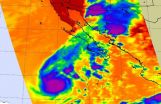NASA sees Tropical Storm Kevin stream high clouds over Baja California
2015-09-04
(Press-News.org) Tropical Storm Kevin's center was several hundred miles south-southwest of Baja California when NASA's Aqua satellite passed overhead and saw some associated high clouds streaming over the peninsula.
The MODIS and the AIRS instruments aboard Aqua captured visible and infrared images of Kevin on September 3 at 20:50 UTC (4:50 p.m. EDT). The visible image from the Moderate Resolution Imaging Spectroradiometer or MODIS instrument provided look at Kevin's clouds. MODIS showed a somewhat elongated tropical storm with a fragmented band of thunderstorms wrapping into the low-level center from the north.
The Atmospheric Infrared Sounder or AIRS image showed that Kevin continued to produce a cluster of convection and developing storms near its center with cloud top temperatures colder than -80 Celsius (-112 Fahrenheit).
The AIRS and MODIS satellite imagery showed high, cold, cirrus clouds were pushed northeast of Kevin's center, and streamed over Baja California. That indicates that southerly vertical wind shear was increasing over the cyclone.
At 5 a.m. EDT (0900 UTC) the center of Tropical Storm Kevin was located near latitude 20.2 North, longitude 115.8 West. That's about 420 miles (680 km) west-southwest of the southern tip of Baja California, Mexico. Maximum sustained winds were near 60 mph (95 kph). Kevin was moving toward the north near 8 mph (13 kph) and a turn to the west-northwest is expected over the next two days.
Forecaster Beven of the National Hurricane Center noted that the forecast track takes Kevin over decreasing sea surface temperatures in an environment of increasing vertical wind shear. Wind shear can tear the circulation of storms apart, so combined with the cooler ocean temperatures, those two factors should cause steady weakening later on September 4, with Kevin forecast to weaken to a depression by September 6 and a remnant low shortly thereafter.
INFORMATION:
[Attachments] See images for this press release:


ELSE PRESS RELEASES FROM THIS DATE:
2015-09-04
Scientists studying how a heat-loving microbe transfers its DNA from one generation to the next say it could further our understanding of an extraordinary superbug.
Sulfolobus is part of the Archaea kingdom - a single-cell organism similar to bacteria - which was isolated in hot springs on the island of Hokkaido, Japan.
Some Archaea live ordinary lives in mundane environments such as lakes, seas and insect and mammal intestinal tracts, while others live extraordinary lives pushed to extremes in incredibly harsh habitats such as deep sea hydrothermal vents, volcanic ...
2015-09-04
"Objects of granular media, such as a sandcastle, consist of millions or billions of grains. The computation time needed to produce photorealistic images amounts to hundreds to thousands of processor hours," Professor Carsten Dachsbacher of the Institute for Visualization and Data Analysis of KIT explains. Materials, such as sand, salt or sugar, consist of randomly oriented grains that are visible at a closer look only. Image synthesis, the so-called rendering, is very difficult, as the paths of millions of light rays through the grains have to be simulated. "In addition, ...
2015-09-04
Nowadays, internet auctions play an important role in online trading. No matter whether you want to buy a hedge trimmer or an antique pocket watch - unlike purchases by a click at a fixed price, online auctions provide the atmosphere of a competition for the auction object. Whoever perceives the competition of real contenders, e.g. by avatars or photos on the screen, wishes to stay in the race - and increases his bid. This is a result of a KIT study with more than 450 test persons.
Online auctions combine shopping with entertainment, fun, and excitement. This is the ...
2015-09-04
Action to prevent tooth decay in children, such as supervised tooth brushing and fluoride varnish schemes, are not just beneficial to children's oral health but could also result in cost savings to the NHS of hundreds of pounds per child, so says a leading dental health researcher.
Professor Elizabeth Kay, Foundation Dean of the Peninsula Dental School from Plymouth University Peninsula Schools of Medicine and Dentistry, has carried out the first economic evaluation of public health measures to reduce tooth decay in children at high risk, in association with the National ...
2015-09-04
When a jogger sets out on his evening run, the active movements of his arms and legs are accompanied by involuntary changes in the position of the head relative to the rest of the body. Yet the jogger does not experience feelings of dizziness like those induced in the passive riders of a rollercoaster, who have no control over the abrupt dips and swoops to which they are exposed. The reason for the difference lies in the vestibular organ (VO) located in the inner ear, which controls balance and posture. The VO senses ongoing self-motion and ensures that, while running, ...
2015-09-04
Patients with cancer of the esophagus--also known as the gullet--are often given chemo- or radiotherapy, with the aim of shrinking the tumor before it is surgically removed. Increasingly positron emission tomography (PET) is being used to monitor the size of the tumor during the treatment. To date, however, no benefit for patients has ensued, as Milly Schröer-Günther and co-authors show in an original article in the current issue of Deutsches Ärzteblatt International (Dtsch Arztebl Int 2015; 112: 545-52).
PET is an imaging technique that makes a tumor in ...
2015-09-04
Despite continued medical advances, infectious diseases kill over 10 million people worldwide each year. The ecological complexity of many emerging disease threats--interactions among multiple hosts, multiple vectors and even multiple parasites--often complicates efforts aimed at controlling disease. Now, a new paper co-authored by a University of Colorado Boulder professor is advancing a multidisciplinary framework that could provide a better mechanistic understanding of emerging outbreaks.
In a study published today in the journal Science, researchers demonstrate how ...
2015-09-04
In the game of wheat genetics, Jorge Dubcovsky's laboratory at UC Davis has hit a grand slam, unveiling for the fourth time in a dozen years a gene that governs wheat vernalization, the biological process requiring cold temperatures to trigger flower formation.
Identification of the newly characterized VRN-D4 gene and its three counterpart genes is crucial for understanding the vernalization process and developing improved varieties of wheat, which provides about one-fifth of the calories and proteins that we humans consume globally.
The new study, reported online in ...
2015-09-04
Girls with autism display less repetitive and restricted behavior than boys do, according to a study by researchers at the Stanford University School of Medicine.
The study also found that brain differences between boys and girls with autism help explain this discrepancy.
The study, which will be published online Sept. 3 in Molecular Autism, gives the best evidence to date that boys and girls exhibit the developmental disorder differently.
"We wanted to know which specific clinical manifestations of autism show significant gender differences, and whether patterns ...
2015-09-04
Each extra hour per day spent watching TV, using the internet or playing computer games during Year 10 is associated with poorer grades at GCSE at age 16, according to research from the University of Cambridge. In a study published today in the open access International Journal of Behavioral Nutrition and Physical Activity, researchers also found that pupils doing an extra hour of daily homework and reading performed significantly better than their peers. However, the level of physical activity had no effect on academic performance.
The link between physical activity ...
LAST 30 PRESS RELEASES:
[Press-News.org] NASA sees Tropical Storm Kevin stream high clouds over Baja California



